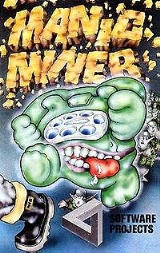
Manic Miner
Encyclopedia
Manic Miner is a platform game
originally written for the ZX Spectrum
by Matthew Smith
and released by Bug-Byte
in 1983
(later re-released by Software Projects
). It is the first game in the Miner Willy
series and among the pioneers of the platform game genre. The game itself was inspired by the Atari 800 game Miner 2049er
. It has since been ported to numerous home computers and video game consoles.
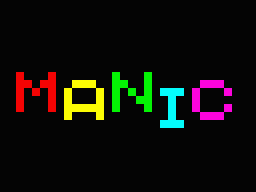 At the time, its stand-out features included in-game music
At the time, its stand-out features included in-game music
and sound effects, excellent playability, and colourful graphics, which were well designed for the graphical limitations of the ZX Spectrum
. The Spectrum's video display allowed the background and foreground colors to be exchanged automatically without software attention and the "animated" load screen appears to swap the words Manic and Miner through clever manipulation of this feature. An homage to this loading screen appeared in one episode of the 2005 British sitcom Nathan Barley
.
On the Spectrum
this was the first game with in-game music, the playing of which required constant CPU attention and was thought impossible. It was cleverly achieved by constantly alternating CPU time between the music and the game (which accounts for the music's stuttery rhythm). The in-game music is In the Hall of the Mountain King
from Edvard Grieg's
music to Henrik Ibsen's
play Peer Gynt
. The music that plays during the title screen is an arrangement of An der schönen blauen Donau
(popularly known as The Blue Danube), a waltz
by Johann Strauß
.
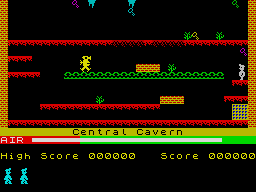
The game ends when the player has no lives left; extra lives are gained every 10,000 points.
is different, to reflect the new copyright
, and there are also several other changes:
It was the winner of a Golden Joystick Award for best arcade style game by Computer & video games magazine in the 1983 edition of the Competition. Placed third in "Game of the Year 1983" of the same competition.
, Commodore 16
, Amstrad CPC
, BBC Micro
, Dragon 32/64
, Commodore Amiga, Oric 1, Game Boy Advance
, MSX
, SAM Coupé
and mobile phone
s.
Unofficial ports exist for the IBM PC
compatibles (Windows
, DOS
and Linux
), Apple Macintosh, Atari ST
, ZX81
, Sony PlayStation
, Nintendo 64
, Neo Geo Pocket Color
, Acorn Archimedes
, Orao
, Z88
, PMD 85
, HP48, and Microsoft Zune
.
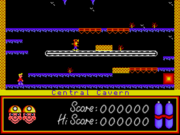 The SAM Coupé
The SAM Coupé
version, programmed by Matthew Holt, like the ZX original requires pixel-perfect timing, and both graphics and audio were greatly updated. In addition to the original twenty caverns, forty additional caverns were included in this release. Levels were designed by David Ledbury, and winners of a competition run by SAM Computers Ltd.
version does not have the Solar Power Generator, instead containing a completely different room called "The Meteor Shower". This has the "reflecting machines" from the Solar Power Generator, but there is no beam of light. Instead, it has meteors which descend from the top of the screen and disintegrate when they hit platforms, like the Skylabs in Skylab Landing Bay. It also has forcefields which turn on and off, and the layout is completely different.
Also, the very last screen (which is still called The Final Barrier) is complex and difficult (unlike the Spectrum version, which is considered to be fairly easy) and has a completely different layout. It also features the blinking forcefields.
version was effectively the same as the Spectrum version by Software Projects, except that Eugene's Lair was renamed "Eugene Was Here," and the layout of The Final Barrier was again completely different (but is more similar to the Spectrum version than the BBC version).
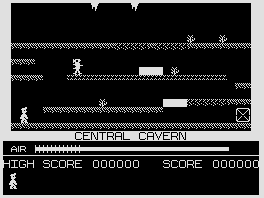 The Dragon 32 version, programmed by Roy Coates, had two extra rooms (i.e. 22 altogether) and a cheat mode accessed by typing "P P PENGUIN". The Archimedes version was converted from the Dragon release.
The Dragon 32 version, programmed by Roy Coates, had two extra rooms (i.e. 22 altogether) and a cheat mode accessed by typing "P P PENGUIN". The Archimedes version was converted from the Dragon release.
port has all the functionality (and cheats) of the Bug-Byte and Software Projects versions. The levels are the same and there is even some background music.
version was limited in a number of respects.
This was mainly due to the initial lack of developer material for the C16 machine,
not to mention the two week deadline to produce the game, test and generate a master tape for the duplication house.
Other issues related to the lack of a 'fast loader' system for the C16 cassette deck, as a result it took nearly 23 minutes for the game to load, and a bug resulted in the game entering the first screen
as soon as the tape had finished loading instead of waiting for the user to start the game. Further issues related to the lack of music and in game sound, and the way that video memory was mapped in the C16, this resulted in a number of the screens having to be removed so that load time and video mapping could be correctly handled.
. In addition quite a few unofficial sequels, remakes, homages and updates have been released, even up to this day, including a ZX81 version.
Platform game
A platform game is a video game characterized by requiring the player to jump to and from suspended platforms or over obstacles . It must be possible to control these jumps and to fall from platforms or miss jumps...
originally written for the ZX Spectrum
ZX Spectrum
The ZX Spectrum is an 8-bit personal home computer released in the United Kingdom in 1982 by Sinclair Research Ltd...
by Matthew Smith
Matthew Smith (games programmer)
Matthew Smith is a British computer game programmer. He is best known for his games Manic Miner and Jet Set Willy for the ZX Spectrum, released in 1983 and 1984 respectively...
and released by Bug-Byte
Bug-Byte
Bug-Byte Software Ltd. was a company founded in 1980 by Tony Baden and Tony Milner, two Oxford chemistry graduates. It was one of the first to develop a range of 8-bit computer games during the early 1980s, for Sinclair, Commodore and other home computer brands, particularly for the Spectrum...
in 1983
1983 in video gaming
-Events:* A major shakeout of the video game industry begins. By 1986, total video games sales will decrease from US$3.2 billion to US$0.1 billion.* MCA Universal files suit against Nintendo, claiming that the latter company's video arcade hit Donkey Kong violated Universal's copyright on King Kong...
(later re-released by Software Projects
Software Projects
Software Projects was the name of a computer game development company which employed Manic Miner developer Matthew Smith. After leaving Bug-Byte as a freelance developer, Smith was able to take the rights to his recently developed Manic Miner game with him, due to an oversight in his freelance...
). It is the first game in the Miner Willy
Miner Willy
Miner Willy is a fictional character in a series of platform games for the ZX Spectrum, MSX, Amstrad CPC and the Commodore 64 home computers starring Miner Willy...
series and among the pioneers of the platform game genre. The game itself was inspired by the Atari 800 game Miner 2049er
Miner 2049er
Miner 2049er is a video game created by Bill Hogue that was released in 1982 by Big Five Software. The game was licensed in conjunction with International Computer Group . At the time of its release, Miner 2049'er was notable for having ten different screens, which was a large number for a platform...
. It has since been ported to numerous home computers and video game consoles.
Gameplay

Computer and video game music
Video game music is any of the musical pieces or soundtracks and background musics found in video games. It can range from a primitive synthesizer tune to an orchestral piece, usually such that the older the game, the simpler the music...
and sound effects, excellent playability, and colourful graphics, which were well designed for the graphical limitations of the ZX Spectrum
Attribute clash
Attribute clash was a display artifact caused by limits in the graphics circuitry of a number of early color 8-bit home computers, most notably the Sinclair Research ZX Spectrum, where it meant that only two colors could be used in any area of 8×8 pixels...
. The Spectrum's video display allowed the background and foreground colors to be exchanged automatically without software attention and the "animated" load screen appears to swap the words Manic and Miner through clever manipulation of this feature. An homage to this loading screen appeared in one episode of the 2005 British sitcom Nathan Barley
Nathan Barley
Nathan Barley is a Channel 4 sitcom written by Charlie Brooker and Chris Morris, starring Nicholas Burns, Julian Barratt and Claire Keelan. The series of six weekly episodes began broadcasting on 11 February 2005 on Channel 4...
.
On the Spectrum
ZX Spectrum
The ZX Spectrum is an 8-bit personal home computer released in the United Kingdom in 1982 by Sinclair Research Ltd...
this was the first game with in-game music, the playing of which required constant CPU attention and was thought impossible. It was cleverly achieved by constantly alternating CPU time between the music and the game (which accounts for the music's stuttery rhythm). The in-game music is In the Hall of the Mountain King
In the Hall of the Mountain King
In the Hall of the Mountain King is a piece of orchestral music composed by Edvard Grieg for the sixth scene of Act II in Henrik Ibsen's play Peer Gynt, which premiered in Christiania on February 24, 1876....
from Edvard Grieg's
Edvard Grieg
Edvard Hagerup Grieg was a Norwegian composer and pianist. He is best known for his Piano Concerto in A minor, for his incidental music to Henrik Ibsen's play Peer Gynt , and for his collection of piano miniatures Lyric Pieces.-Biography:Edvard Hagerup Grieg was born in...
music to Henrik Ibsen's
Henrik Ibsen
Henrik Ibsen was a major 19th-century Norwegian playwright, theatre director, and poet. He is often referred to as "the father of prose drama" and is one of the founders of Modernism in the theatre...
play Peer Gynt
Peer Gynt
Peer Gynt is a five-act play in verse by the Norwegian dramatist Henrik Ibsen, loosely based on the fairy tale Per Gynt. It is the most widely performed Norwegian play. According to Klaus Van Den Berg, the "cinematic script blends poetry with social satire and realistic scenes with surreal ones"...
. The music that plays during the title screen is an arrangement of An der schönen blauen Donau
The Blue Danube
The Blue Danube is the common English title of An der schönen blauen Donau, Op. 314 , a waltz by the Austrian composer Johann Strauss II, composed in 1866...
(popularly known as The Blue Danube), a waltz
Waltz
The waltz is a ballroom and folk dance in time, performed primarily in closed position.- History :There are several references to a sliding or gliding dance,- a waltz, from the 16th century including the representations of the printer H.S. Beheim...
by Johann Strauß
Johann Strauss II
Johann Strauss II , also known as Johann Baptist Strauss or Johann Strauss, Jr., the Younger, or the Son , was an Austrian composer of light music, particularly dance music and operettas. He composed over 500 waltzes, polkas, quadrilles, and other types of dance music, as well as several operettas...
.

Objective
In each of the twenty caverns are several flashing objects, which the player must collect before Willy's oxygen supply runs out. Once the player has collected the objects in one cavern, they must then go to the now-flashing portal, which will take them to the next cavern. The player must avoid enemies (listed in the cassette inlay) as "...Poisonous Pansies, Spiders, Slime, and Manic Mining Robots...", which move along predefined paths at constant speeds. Willy can also be killed by falling too far, so players must time the precision of jumps and other movements to prevent such falls or collisions with the enemies.The game ends when the player has no lives left; extra lives are gained every 10,000 points.
Version differences
There are some differences between the Bug-Byte and Software Projects versions. The scroll-text during the attract modeAttract mode
Attract mode is an arcade game's screen display shown when no one is playing the game. The main purpose of the attract mode is to attract passers-by to play the game, although it might also have the side effect to act like a screensaver.-Summary:...
is different, to reflect the new copyright
Copyright
Copyright is a legal concept, enacted by most governments, giving the creator of an original work exclusive rights to it, usually for a limited time...
, and there are also several other changes:
- In Processing Plant, the enemy at the end of the conveyor belt is a bush in the original, whereas the Software Projects one resembles a PacMan ghost.
- In Amoebatrons' Revenge, the original Bug-Byte amoebatrons look like alien octopuses with tentacles hanging down, whereas the Software Projects amoebatrons resemble the Bug-Byte logo - smiling beetles, with little legs up their sides.
- In The Warehouse, the original game has threshers travelling up and down the vertical slots, rotating about the screen's X-axis. The Software Projects version has 'impossible trianglePenrose triangleThe Penrose triangle, also known as the Penrose tribar, is an impossible object. It was first created by the Swedish artist Oscar Reutersvärd in 1934. The mathematician Roger Penrose independently devised and popularised it in the 1950s, describing it as "impossibility in its purest form". It is...
' sprites (i.e. the Software Projects logo) instead, which rotate about the screen's Z-axis. - The Bug-Byte cheat code was the numerical sequence "6031769" - based on Matthew Smith's driving licence. In the Software Projects version this changed to "typewriter". (Smith would later use the code "writetyper" to activate the cheat mode for Jet Set WillyJet Set WillyJet Set Willy is a computer game originally written for the ZX Spectrum home computer. It was published in 1984 by Software Projects and ported to most home computers of the time....
.)
Reception
Manic Miner was placed at number 25 in the Your Sinclair official top 100 Spectrum games of all time, and was voted number 6 in the Readers' Top 100 Games of All Time in the same issue.It was the winner of a Golden Joystick Award for best arcade style game by Computer & video games magazine in the 1983 edition of the Competition. Placed third in "Game of the Year 1983" of the same competition.
Ports
Official ports exist for the Commodore 64Commodore 64
The Commodore 64 is an 8-bit home computer introduced by Commodore International in January 1982.Volume production started in the spring of 1982, with machines being released on to the market in August at a price of US$595...
, Commodore 16
Commodore 16
The Commodore 16 was a home computer made by Commodore with a 6502-compatible 8501 CPU, released in 1984. It was intended to be an entry-level computer to replace the VIC-20 and it often sold for 99 USD...
, Amstrad CPC
Amstrad CPC
The Amstrad CPC is a series of 8-bit home computers produced by Amstrad between 1984 and 1990. It was designed to compete in the mid-1980s home computer market dominated by the Commodore 64 and the Sinclair ZX Spectrum, where it successfully established itself primarily in the United Kingdom,...
, BBC Micro
BBC Micro
The BBC Microcomputer System, or BBC Micro, was a series of microcomputers and associated peripherals designed and built by Acorn Computers for the BBC Computer Literacy Project, operated by the British Broadcasting Corporation...
, Dragon 32/64
Dragon 32/64
The Dragon 32 and Dragon 64 are home computers that were built in the 1980s. The Dragons are very similar to the TRS-80 Color Computer , and were produced for the European market by Dragon Data, Ltd., in Port Talbot, Wales, and for the US market by Tano of New Orleans, Louisiana...
, Commodore Amiga, Oric 1, Game Boy Advance
Game Boy Advance
The is a 32-bit handheld video game console developed, manufactured, and marketed by Nintendo. It is the successor to the Game Boy Color. It was released in Japan on March 21, 2001; in North America on June 11, 2001; in Australia and Europe on June 22, 2001; and in the People's Republic of China...
, MSX
MSX
MSX was the name of a standardized home computer architecture in the 1980s conceived by Kazuhiko Nishi, then Vice-president at Microsoft Japan and Director at ASCII Corporation...
, SAM Coupé
SAM Coupé
The SAM Coupé is an 8-bit British home computer that was first released in late 1989. It is commonly considered a clone of the Sinclair ZX Spectrum computer, since it features a compatible screen mode and emulated compatibility, and it was marketed as a logical upgrade from the Spectrum...
and mobile phone
Mobile phone
A mobile phone is a device which can make and receive telephone calls over a radio link whilst moving around a wide geographic area. It does so by connecting to a cellular network provided by a mobile network operator...
s.
Unofficial ports exist for the IBM PC
IBM PC
The IBM Personal Computer, commonly known as the IBM PC, is the original version and progenitor of the IBM PC compatible hardware platform. It is IBM model number 5150, and was introduced on August 12, 1981...
compatibles (Windows
Microsoft Windows
Microsoft Windows is a series of operating systems produced by Microsoft.Microsoft introduced an operating environment named Windows on November 20, 1985 as an add-on to MS-DOS in response to the growing interest in graphical user interfaces . Microsoft Windows came to dominate the world's personal...
, DOS
DOS
DOS, short for "Disk Operating System", is an acronym for several closely related operating systems that dominated the IBM PC compatible market between 1981 and 1995, or until about 2000 if one includes the partially DOS-based Microsoft Windows versions 95, 98, and Millennium Edition.Related...
and Linux
Linux
Linux is a Unix-like computer operating system assembled under the model of free and open source software development and distribution. The defining component of any Linux system is the Linux kernel, an operating system kernel first released October 5, 1991 by Linus Torvalds...
), Apple Macintosh, Atari ST
Atari ST
The Atari ST is a home/personal computer that was released by Atari Corporation in 1985 and commercially available from that summer into the early 1990s. The "ST" officially stands for "Sixteen/Thirty-two", which referred to the Motorola 68000's 16-bit external bus and 32-bit internals...
, ZX81
Sinclair ZX81
The ZX81 was a home computer produced by Sinclair Research and manufactured in Scotland by Timex Corporation. It was launched in the United Kingdom in March 1981 as the successor to Sinclair's ZX80 and was designed to be a low-cost introduction to home computing for the general public...
, Sony PlayStation
PlayStation
The is a 32-bit fifth-generation video game console first released by Sony Computer Entertainment in Japan on December 3, .The PlayStation was the first of the PlayStation series of consoles and handheld game devices. The PlayStation 2 was the console's successor in 2000...
, Nintendo 64
Nintendo 64
The , often referred to as N64, was Nintendo′s third home video game console for the international market. Named for its 64-bit CPU, it was released in June 1996 in Japan, September 1996 in North America, March 1997 in Europe and Australia, September 1997 in France and December 1997 in Brazil...
, Neo Geo Pocket Color
Neo Geo Pocket Color
The Neo Geo Pocket Color , is a 16-bit colour handheld game console by SNK. It was the last console they produced in the Neo Geo family...
, Acorn Archimedes
Acorn Archimedes
The Acorn Archimedes was Acorn Computers Ltd's first general purpose home computer to be based on their own ARM architecture.Using a RISC design with a 32-bit CPU, at its launch in June 1987, the Archimedes was stated as running at 4 MIPS, with a claim of 18 MIPS during tests.The name is commonly...
, Orao
Orao (computer)
Orao was an 8-bit computer developed by PEL Varaždin in 1984. It was used as a standard primary school computer in Croatia and Vojvodina from 1985 to 1991....
, Z88
Cambridge Z88
The Cambridge Computer Z88 is an A4-size, lightweight, portable Z80-based computer with a built-in combined word processing/spreadsheet/database application called PipeDream, along with several other applications and utilities, such as a Z80-version of the BBC BASIC programming language.The Z88...
, PMD 85
PMD 85
The PMD 85 was an 8-bit personal computer produced from 1985 by the companies Tesla Piešťany and Bratislava in the former Czechoslovakia.They were deployed en masse in schools throughout Slovakia, while the IQ 151 performed a similar role in Czech part of the country.PMD 85s were famous for their...
, HP48, and Microsoft Zune
Zune
Zune is a digital media brand owned by Microsoft which includes a line of portable media players, a digital media player software for Windows machines, a music subscription service known as a 'Zune Music Pass', music and video streaming for the Xbox 360 via the Zune Software, music, TV and movie...
.
SAM Coupé

SAM Coupé
The SAM Coupé is an 8-bit British home computer that was first released in late 1989. It is commonly considered a clone of the Sinclair ZX Spectrum computer, since it features a compatible screen mode and emulated compatibility, and it was marketed as a logical upgrade from the Spectrum...
version, programmed by Matthew Holt, like the ZX original requires pixel-perfect timing, and both graphics and audio were greatly updated. In addition to the original twenty caverns, forty additional caverns were included in this release. Levels were designed by David Ledbury, and winners of a competition run by SAM Computers Ltd.
BBC Micro
The BBC MicroBBC Micro
The BBC Microcomputer System, or BBC Micro, was a series of microcomputers and associated peripherals designed and built by Acorn Computers for the BBC Computer Literacy Project, operated by the British Broadcasting Corporation...
version does not have the Solar Power Generator, instead containing a completely different room called "The Meteor Shower". This has the "reflecting machines" from the Solar Power Generator, but there is no beam of light. Instead, it has meteors which descend from the top of the screen and disintegrate when they hit platforms, like the Skylabs in Skylab Landing Bay. It also has forcefields which turn on and off, and the layout is completely different.
Also, the very last screen (which is still called The Final Barrier) is complex and difficult (unlike the Spectrum version, which is considered to be fairly easy) and has a completely different layout. It also features the blinking forcefields.
Amstrad CPC
The AmstradAmstrad CPC
The Amstrad CPC is a series of 8-bit home computers produced by Amstrad between 1984 and 1990. It was designed to compete in the mid-1980s home computer market dominated by the Commodore 64 and the Sinclair ZX Spectrum, where it successfully established itself primarily in the United Kingdom,...
version was effectively the same as the Spectrum version by Software Projects, except that Eugene's Lair was renamed "Eugene Was Here," and the layout of The Final Barrier was again completely different (but is more similar to the Spectrum version than the BBC version).
Dragon 32/64

Z88
The Z88Cambridge Z88
The Cambridge Computer Z88 is an A4-size, lightweight, portable Z80-based computer with a built-in combined word processing/spreadsheet/database application called PipeDream, along with several other applications and utilities, such as a Z80-version of the BBC BASIC programming language.The Z88...
port has all the functionality (and cheats) of the Bug-Byte and Software Projects versions. The levels are the same and there is even some background music.
HP48
The HP48 version is somewhat limited by the low resolution screen size, scrolling the area rather than displaying the level as a whole. This makes it a very difficult port for those who have not previously mastered another version. Otherwise it is fairly loyal to the ZX Spectrum version. Sound is somewhat different sounding and colour omitted for obvious hardware reasons, but game play remains similar despite the awkward platform.Commodore 16
The Commodore 16Commodore 16
The Commodore 16 was a home computer made by Commodore with a 6502-compatible 8501 CPU, released in 1984. It was intended to be an entry-level computer to replace the VIC-20 and it often sold for 99 USD...
version was limited in a number of respects.
This was mainly due to the initial lack of developer material for the C16 machine,
not to mention the two week deadline to produce the game, test and generate a master tape for the duplication house.
Other issues related to the lack of a 'fast loader' system for the C16 cassette deck, as a result it took nearly 23 minutes for the game to load, and a bug resulted in the game entering the first screen
as soon as the tape had finished loading instead of waiting for the user to start the game. Further issues related to the lack of music and in game sound, and the way that video memory was mapped in the C16, this resulted in a number of the screens having to be removed so that load time and video mapping could be correctly handled.
Sequels
The sequel to Manic Miner is Jet Set WillyJet Set Willy
Jet Set Willy is a computer game originally written for the ZX Spectrum home computer. It was published in 1984 by Software Projects and ported to most home computers of the time....
. In addition quite a few unofficial sequels, remakes, homages and updates have been released, even up to this day, including a ZX81 version.
See also
- Miner Willy series of gamesMiner WillyMiner Willy is a fictional character in a series of platform games for the ZX Spectrum, MSX, Amstrad CPC and the Commodore 64 home computers starring Miner Willy...
- Roller CoasterRoller Coaster (video game)Roller Coaster is a platform-based game which contains some strategy and puzzle elements. Uniquely it holds the claim of being the first video game to ever simulate amusement rides....
- Miner 2049erMiner 2049erMiner 2049er is a video game created by Bill Hogue that was released in 1982 by Big Five Software. The game was licensed in conjunction with International Computer Group . At the time of its release, Miner 2049'er was notable for having ten different screens, which was a large number for a platform...
- Sir LancelotSir Lancelot (game)Sir Lancelot is a video game published in 1984 by Melbourne House for the Amstrad CPC and ZX Spectrum home computers.-Overview:Sir Lancelot, controlled by the player, must explore the 24 rooms of the castle and collect all the objects in each room before making his way to the exit to the next...

